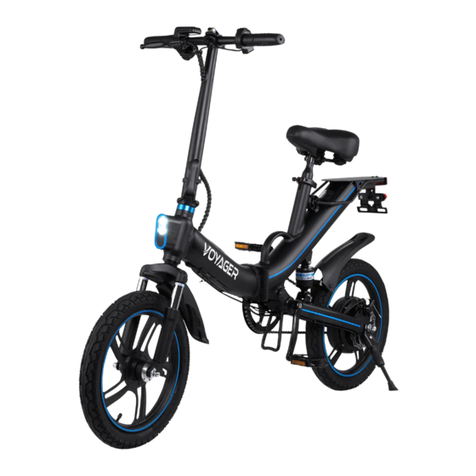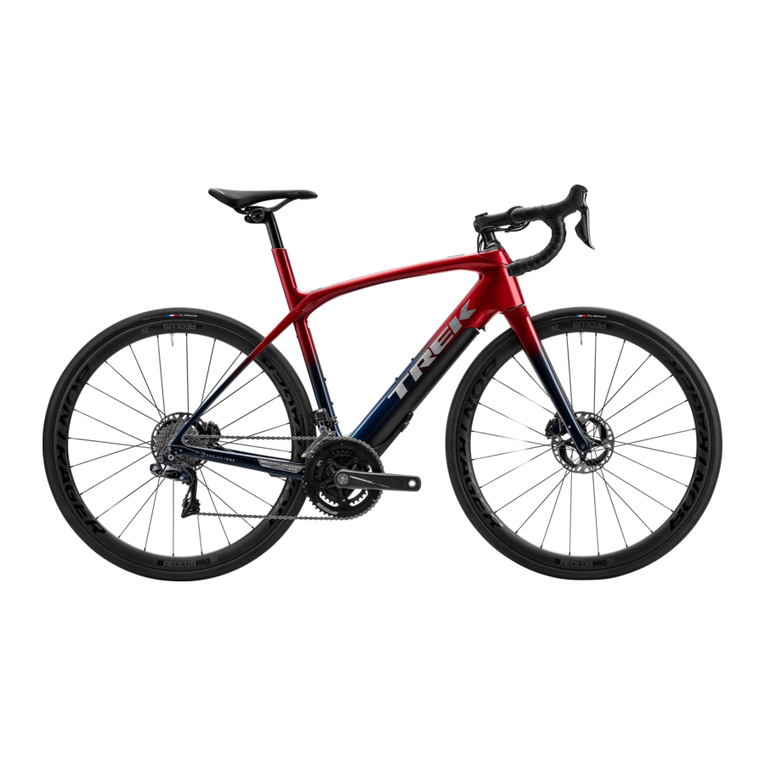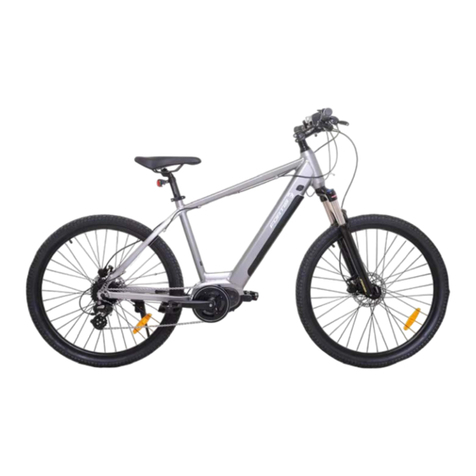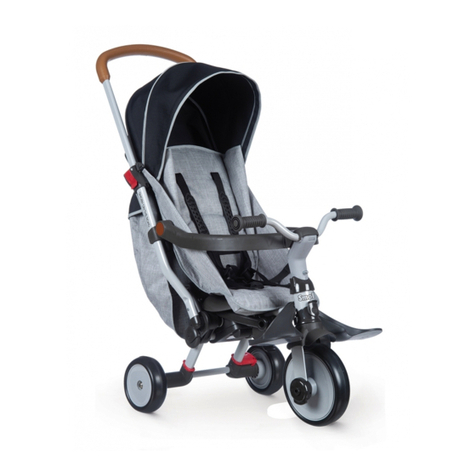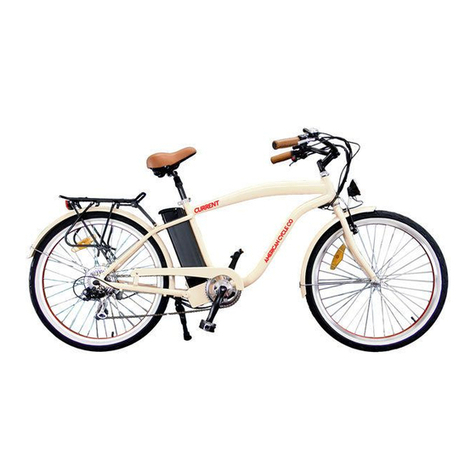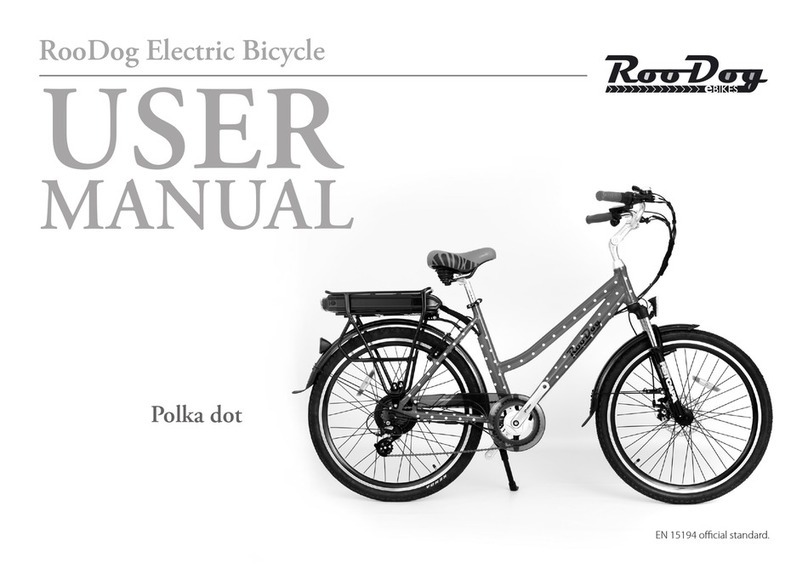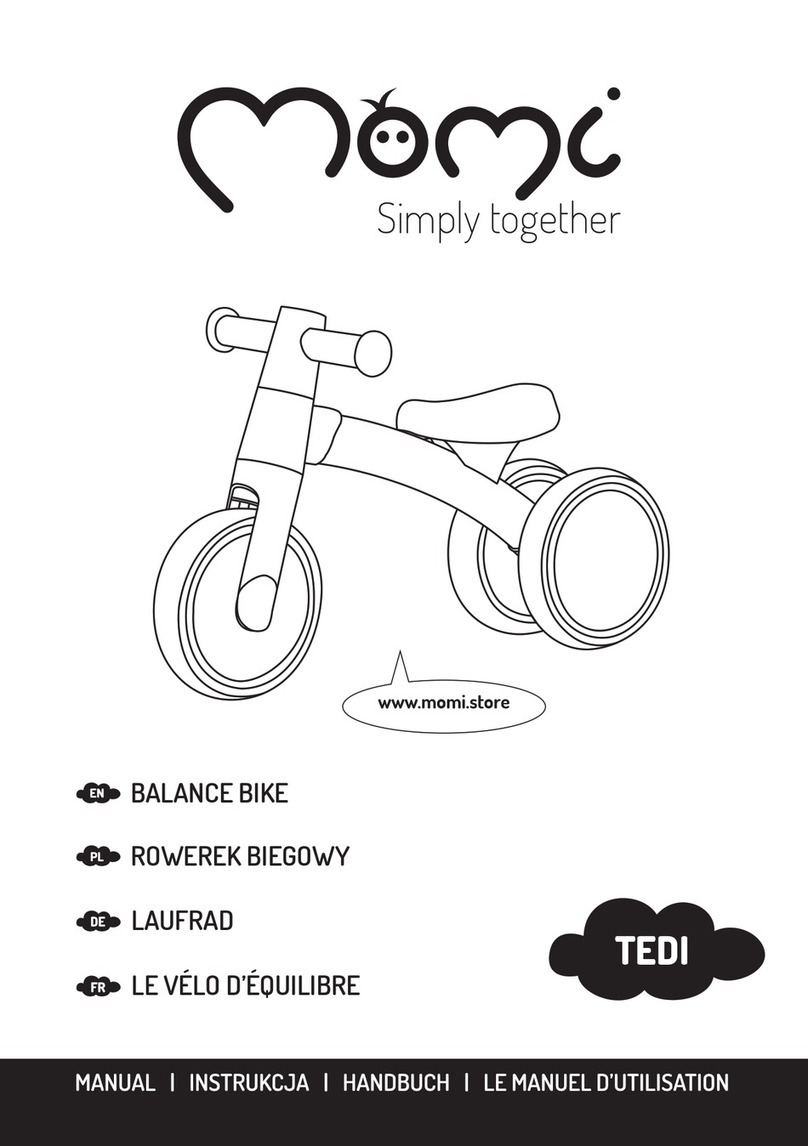GoBike Welcome User manual

Welcome
© 2007, Le Groupe GO inc., all rights reserved, GoBike ® and the GoMan® logo are registered trade marks of Le Groupe GO inc.
歓迎 BenvenutoWillkommen RecepciónWelkomBienvenue
Owner’s manual
v1.2 March 2007
gobikeworld.com

2
Contents
3 Introduction
4 Getting acquainted with your GoBike
5 Important general information
6 Before your first ride
6 Before every ride
7 Unfolding the GoBike
12 Folding the GoBike
17 Fitting the GoBike to the rider
19 How do I use a quick-release?
20 Braking system
21 Gear system
22 Chain care
22 Wheels and tires
23 Fixing a puncture on the rear wheel
25 Fixing a puncture on the front wheel
25 Steering or headset bearings
26 General care and inspection tips

3
Introduction
Dear customer,
Congratulations and welcome to the growing family of GoBike users and enthusiasts of
fresh new solutions in modern mobility! Your GoBike is a very high tech bike. It comprises
a selection of forward-minded features and thoroughly-developed and manufactured
components, all fully tested to give you years of safe and enjoyable bike riding.
In this manual we’ve gathered together plenty of tips about using your bike, along with
valuable information about cycle technology, care and maintenance. The GoBike takes
advantage of unusually innovative technology, so even if you consider yourself familiar and
knowledgeable with riding bikes and bicycle technology, do read and observe the
following tips carefully before you first use the bike. There are a whole series of
maintenance and assembly procedures described in this manual. If you carry out any of
these, you must always remember that the instructions apply only to the GoBike and not
to any other bike. It’s also possible that because of the wide range of models, and regular
model changes, that the instructions are not entirely complete. We ask for your compre-
hension if that is the case.
With this in mind, always follow the instructions provided by the component
manufacturers included with this manual, or which will be given to you by your
GoBike reseller.
Also consider that the explanations may, depending on your level of experience and
mechanical aptitude, be insufficient, and may also require special tools and knowledge of
common (not described here) mechanical operations.
Warning: In the interests of your own safety, don’t go beyond your limits. If you are in any
doubt consult your GoBike reseller
To conclude this introduction, we would like to remind you of a few things important for
any cyclist. In traffic, always ride with full attention, so that you do not endanger yourself
or others. Observe traffic laws and regulations of the country or state where you will be
riding your bike, so that you don’t attract the anger of other road users. Respect nature
when you’re riding in the countryside. Ride only on marked and surfaced roads. Observe
any laws and regulations for the use of bicycles off-road – including regional or local
bye-laws. Never ride without a helmet, and wear bright or light coloured clothing so you
can easily be seen. Never ride at night without reflectors and a proper lighting system.
We hope you have great fun on your new GoBike!

4
1. Saddle
2. Seat post
3. Seat post collar and quick release
4. Rear fork
5. Rear suspension
6. Rear wheel
7.Rear disk brake
8. Derailleur
9. Rim
10. Cassette
11. Chain
12. GoBell
13. Main frame
14. Main frame pivot quick release
15. Crank set
16. Fork elbow pull knob
17. Shifter
18. Brake lever
19. Folding stem mechanism
20. Front fork
21. Front suspension pull knob
22. Front disk brake
23. Front wheel
24. Spokes
Getting acquainted with your GoBike
If you encounter any unfamiliar words while reading this manual, please refer to this picture
and glossary.

5
Important general information
About this manual :
Throughout this manual, we use a system of warnings and tips to draw your attention to
important features and safety guidelines to ensure a safe and pleasurable experience rid-
ing your GoBike. These special notices are identified by the following labels:
WARNINGS
TIPS
GENERAL WARNING
Even under the best conditions, bicycling can be a hazardous activity.
It is the owner’s responsibility to carefully follow the information presented in this manual.
Read and understand the information on the following pages and perform the proper
required maintenance to help reduce the risk of injury to you or others as well as the high
performance of your GoBike, If you have any questions concerning the operation, main-
tenance of your new bicycle, be sure to ask your authorized GoBike reseller. Retain this
manual for future reference.
Design limitations of the GoBike
Even though the GoBike has been designed to perform and ride like a full size bicycle with
the least of compromises, it remains a compact wheeled folding bicycle with some limita-
tions and specific ride characteriscs.
Please be advised that:
The GoBike is NOT designed for stunts or jumps.
The GoBike is NOT designed for off-road riding as can be performed by a mountain
bike.
Warnings are used to draw your attention to extremely important details, where
failure to perform the procedure correctly or pay attention to the warning may
result in serious injury or even death. These messages should be read and
thoroughly understood before you ride your GoBike.
Tips are there to draw your attention to valuable advice that will enable you to
better enjoy your GoBike experience.

6
Before the first ride
Please perform the following safety checks :
1. Load capacity
The GoBike is designed for a maximum rider height of around 1.95m (6’ 5“) – depending
on leg length – and for a maximum loading (rider weight and luggage weight) of 110kg
(245lb). Exceeding these parameters could damage the frame and void your warranty or
lead to a serious accident.
2. Use the GoBike only on streets and surfaced roads.
We can take no responsibility for the consequences of inappropriate use, assembly errors,
accidents, racing, jumping or similar activities.
3. Are you confident using the brakes?
Check whether the front brake is operated with the lever you usually use. If this isn’t the
case, you should get used to the arrangement thoroughly, as an unintended application
of the front brake can lead to a fall. Modern brakes are much more powerful than old
ones, especially disk brakes which are a standard feature on all GoBike front wheels! (rear
optional) Take care! In any case, before you take to the streets, test your brakes and get
familiar with them away from the traffic!
4. Are you confident that you know how to change gear, and how the gears work?
Ensure that you’re familiar with the gears somewhere where there’s no traffic.
5. Are saddle and handlebars correctly adjusted?
The saddle should be adjusted so that with the pedal in its lowest position, you can just
reach it with your heel. Check that you can stay in the saddle and still reach the ground
with the tip of your toes.
Before every ride
Before every ride, you must check the following points:
1. Is the main frame pivot quick-release lever and nut tightly closed and safety locking
feature engaged?
2. Are the quick-releases and nuts on the seat post collar and rear wheel all correctly and
tightly fastened?
3. Is the handwheel securing the folding stem mechanism tightly srewed in? Is the hinge
bolt and nut for the stem folding mechanism present, and tightly secured?
4. Is the telescopic stem collar tightly secured?
5. Is the front suspension spring assembly securely latched by the front suspension pull
knob?
6. Are the tires in good condition, do they run round and are they at the correct pressure?

7
7. Perform a stationary brake test by pulling the levers hard towards the handlebar. You
should not be able to pull the lever right up to the handlebar! If so, please ensure your
brakes are ajusted to give you their full braking capacity.
WARNING
8. As you ride, always listen out for unusual rattling noises or unusual handling – these
could indicate a problem. If this occurs, check bearings, pivots, all fastenings and parts of
the folding mechanism.
Unfolding the GoBike
Make your GoBike ready to ride by following this step by step procedure. For a quick and
easy procedure it is important that you perform it in the same sequence described below:
1. Unpack the bike (optional)
Pull the bike from the box and gently remove all protective material. Save the attached
documents for future reference.
TIP
Do not ride the bike if your bike fails any of these checks! In case of doubt,
consult your GoBike reseller. A defective bike can lead to serious accidents!
We strongly recommend you leave all the protective stickers and necessary ma-
terial on your bike in order not to damage the bicycle while you get acquainted
with the folding and unfolding of your new GoBike. We also advise you to do so
over a carpet or any soft underlay. Keep all your packing material and the ship-
ping box in case you need to repack the bicycle to send it for servicing.

8
2. Unfold the handlebar/stem assembly
1/ Stand on the left side of your GoBike (that is the opposite to where the crankset is).
2/ Unfold the hadlebar/stem assembly upwards. 3/ 4/ Rotate the handwheel clockwise
until the folding mechanism wedge piece is firmly locking the folding mechanism.
1. 2.
3. 4.

9
3. Unfold the front fork
1/ Gently rotate the handlebar as if you where turning left to move the front wheel slightly
away from the bike. 2/ Reach down and release the front wheel from its folded position by
pulling on the fork elbow pull-knob. 3/ Lifting the bike up will enable the wheel to rotate
forward to its riding position. When the wheel has swung forward, bring the bike down so
that the front suspension spring assembly pin latches-into its cylinder. 4/ Check if the front
suspension pull knob is securing the wheel in place.
1. 2.
3. 4.

10
4. Pull up the seat post.
1/ Open the seat quick-release lever, 2/ pull-up the saddle to your required riding height
and close the quick-release. To help with this procedure, you can gently lift up the rear
wheel to allow the seat post to easily slide against the rear fork stays and bridges.
WARNING
TIP
1. 2.
Never ride with the seatpost pulled out beyond the “Minimum Insertion” mark.
(Ensure that you have seen this mark on the seat post and are familiar with
what it looks like.)
For easier reference, you can mark the seat post with a pencil or marker to indi-
cate your optimum riding position, but do NOT scratch the surface of the seat
post with any object. Any scratch into the surface may alter the strength of the
anodised aluminium seatpost.

11
5. Unfold the rear fork
1/ Gently rotate the handlebar as if you where turning left to move the front wheel slightly
away from the bike. At the same time, lift the bike up by the saddle so that the rear wheel
swings backwards. 2/ When the back wheel has swung to the back, gently bring the bike
back down while checking that the forward fork ends of the rear fork engage properly onto
the main frame pivot. Ensure that the cables are in their proper position. 3/ Tightly secure
the frame pivot quick-release and make sure the safety locking feature is activated.
4/ Enjoy the ride!
1. 2.
3. 4.

12
Folding the GoBike
The folding procedure is essentially the same as the unfolding procedure but in reverse
order. With a little practice you can easily fold the GoBike in 20 seconds. Again, standing
on the left side of the bike (opposite side of the crankset) is easier. The procedure goes as
follows:
1. Fold the rear fork
1/ 2/ Bend down to reach the main frame quick release. 3/ 4/ To open the main frame pivot
quick-release, you must remember to push on the safety lock button on the side of the
lever to allow it to open. 5/ 6/ If you gently lift the rear of the bike with your right hand, you
will notice that the rear fork remains in place. A safety feature has been built into our rear
fork latching system.To allow the rear fork to fold-down, simply push-in the lever side of
the quick-release to disengage the left nut from its cavity. 7/ Allow the rear wheel to rotate
a full 180 degrees. Ensure that the front wheel is not in the way of the rear wheel when
folding by turning the handlebar as if you were turning left. The wheel will then automati-
cally deflect towards the left of the frame thanks to our ingenious cam system. 8/ Bring the
back of the bike down to the ground.
1. 2.
TIP
This step may be facilitated if you ensure that the right-hand pedal points
upwards (crankset side). The crank should be in line with the seatpost.

13
3. 4.
5. 6.

14
7. 8.
2. Push down the seat post.
1/ 2/ Open the seat quick-release lever and let the seat post slide down. With your left
hand, pull-up the rear wheel, this will allow the seat post to slide over the fork bridge. At
this point, the rear fork is locked in its folded position. Close the seat quick release.
TIP
1. 2.
During the sliding down of the seat post, pay attention not to scratch the rear
fork. This can be avoided easily by lifting the back wheel with your left hand to let
the post slide smoothly against the rear fork bridge.

15
3. Fold the front wheel.
1/ 2/ With your left hand on the handlebar, impose a sligh turn of the handlebar towards
the left (counter clockwise), bend down to release the front spring unit from its cylinder
catch by pulling on the knob. Lift up the front end of the bike, the wheel should naturally
begin its rotation. 3/ Swing the wheel around by over 180 degrees until it clics into its final
folded position. 4/ Gently bring the front wheel towards the rear wheel until they are near
parallel to each other. In order to achieve this, you will need to rotate the front wheel until
you can fit the rear derailleur between the widest distance allowed by the front wheel’s
spoke pattern. Don’t worry, this will not damage the rear derailleur in any way.
1. 2.
3. 4.

16
4. Fold the handlebar assembly.
1/ 2/ Unscrew the stem’s handwheel until the front wedge clears the folding plates. Fold
down the handlebar until it rests on the rear tire. Voilà! 3/ Folded up, your GoBike can now
be easily transported in the trunk of a car, and also on trains, buses, aeroplanes.
1. 2.
3.

17
Fitting the GoBike to the rider
How can I check my seated position?
A good riding position is important for your comfort and for optimal performance on the
bike. You need to adjust saddle and handlebars as precisely as possible to fit. Several
components on the GoBike are designed to adjust the fit to suit your body dimensions.
These include the seatpost, the stem assembly and the brake levers.
DANGER
Adjusting for the correct saddle height
The need for a comfortable pedalling action determines the saddle height. It’s important
that when you pedal, the ball of the foot should be over the centre of the pedal axle. When
the pedal is at its lowest position your leg should not be quite fully extended. If the saddle
is too high, it’s hard to get round this lowest point, and the pedalling action becomes
uneven. If the saddle is too low, you’re likely to experience knee pain.
Check the seat height using the following simple procedure. Use shoes with a flat sole for
this check:
• Sit on the saddle and put your heel on the
pedal, so that it moves to its lowest position.
In this position the leg should be fully extended.
Note that the hips should stay straight and level.
To adjust the seat height, you need to open the
quick-release. Do not pull the seatpost out
beyond the marking on the tube surface.
• The loosened seatpost can now be adjusted
for height. Make sure that the seatpost isn’t
greased. If it doesn’t slide smoothly in the frame,
clean out and remove all grease from inside the
frame and on the seatpost. If you have further
problems, consult your GoBike reseller. In
no event use force to move the seatpost.
• Re-fasten the quick-release.
• Check that the seatpost is securely fixed by
grasping the front and rear of the saddle and
attempting to twist it. If it doesn’t move at all,
it’s secure.
• Does the leg extension seem correct when you repeat the test? Check it by moving your
foot to the ideal pedalling position, with the ball of the foot above the pedal axle. The knee
should now be slightly bent – if this is so, you’ve reached the correct saddle height.
All of the procedures we are about to describe require a certain degree of skill,
suitable tools and mechanical aptitude. After any assembly operation perform
the Quick Check and take a short test-ride somewhere quiet, away from traffic.
This lets you safely check that everything works properly.

18
• Check that you can stay in the saddle and still reach the ground with your tiptoes. If this
isn’t the case, put the saddle a little lower.
DANGER
Adjusting the handlebars
You can adjust the height of the telescopic stem by unscrewing the 6mm bolt of the stem
collar. Your GoBike stem allows for 90mm of height ajustment. Other possibilities for
changing the riding position include adding bar ends or similar handlebar extensions, or
mounting a different handlebar. Gear and brake cables may need to be lengthened in this
case.
• Check that everything is secure on the stem, by holding the front wheel between your
legs and attempting to twist the handlebars with your hands. If it doesn’t turn, it’s secure.
DANGER
Adjusting the reach of the brake levers
The distance between brake levers and handlebar grips is adjustable. The levers can be
brought closer to the bars, making them easier to use for riders with small hands. The
lever position where the brakes start to ‘bite’ also needs to be adjusted for finger length.
• Check when the brake blocks hit the rim for
V-brakes or when the pads hit the disk for disk
brakes. If this ‘bite point’ comes after just a short
movement of the levers, you’ll have to adjust the
cable if you want to adjust lever reach.
Otherwise, the brakes may rub on the rims
or disk after the reach adjustment. If, however,
the brakes only bite after the levers are halfway
to the bars, you have some ‘play’ with which to
adjust lever reach.
• There’s a small adjuster 2mm Allen screw just near where the cable goes into the lever
housing (see arrow on diagram). Screw this adjuster in, and observe how the lever position
changes.
• When you’ve reached the desired position, you must check that there’s still enough
available motion so that there’s a little lever movement before the brakes ‘bite’.
DANGER
Do not ride if the seatpost is withdrawn beyond the ‘MINIMUM INSERTION’
mark! This marking must not be visible: if it is, the seatpost could break or the
frame could be damaged.
Do not ride your GoBike if the telescopic stem is withdrawn beyond the ‘MINI-
MUM INSERTION’ mark!
You shouldn’t be able to pull the levers all the way to the handlebar! Maximum
braking power should be reached before this!

19
How do I use a quick-release?
Quick-releases hold wheels, seatpost and the rear fork in position.
DANGER
A quick-release consists of two basic parts: (Please see page 13 for pictures)
- The lever on one side: this provides the clamping force.
- The adjusting nut on the other side: by adjusting this on the screw thread, the clamping
tension can be adjusted.
The procedure goes as follows:
• Open the quick-release by pivoting the lever until it is in parallel to the axle of the quick-
release.
• To close the quick-release, move the lever so it becomes perpendicular to the axle of
the quick release. At the start of the lever’s motion, for say, half of its movement, the lever
should move very easily, without any clamping action. In the second half of the lever’s
movement, the force on the lever should rise considerably. At the end, it should be hard
to move. Use the ball of your hand. In its final position the lever should lie parallel with the
riding plane of the bike, and should not stick out to one side.
• Check the security of the lever by attempting to twist the lever. Press on the end of the
lever from above.
• If the lever can be made to pivot around in a circle, you can’t guarantee that the seat-
post, wheels or frame pivot adjustment is secure. You must re-open the quick-release and
increase the clamping tension. Do this by screwing the adjusting nut on the other end of
the quick-release half a turn clockwise.
• Repeat the closing procedure and check that the lever is secure. If the lever can’t be
rotated, it’s clamping properly.
Specific safety considerations regarding the main frame pivot quick-release
The main fram quick-release lever has been fitted with a special safety feature preventing
the lever from opening during use. When closing the main frame quick-release according
to the the technique described above, this safety locking device will automatically click in.
To check if the locking mechanism is activated, pull on the lever as if to open it.
You should not be able to pivot the lever more than a few degrees.
To open the lever, you need to push on the button situated on the right hand side of the
lever, this will release the locking feature and allow you to fully open the quick-release.
TIP
An incompletely or improperly closed quick-release can result in parts coming
loose, and hence in a crash, possibly resulting in serious injury!
Components secured by quick-release are more susceptible to theft. Secure
your rear wheel and if necessary saddle with an extra lock, if you’re leaving your
GoBike unattended.

20
Braking system
The GoBike is equipped with particularly powerful brakes especially when considering the
front disk brake that equips all of our models (rear disk optional on some models). Braking
distance is, however, very much determined by the rider’s skill, and can be improved with
practice. Weight is transferred from the rear to the front when you brake, and loading on
the rear wheel reduces. This is why braking distance is determined first by the tendency
of the bike to flip you over the bars, and only as a second order effect by the limits of
adhesion of the tire. This problem becomes particularly acute when descending steeply. If
you use full braking, ensure that your weight is placed as far back as possible. Use both
brakes simultaneously and note that because of the weight transfer effect, the front brake
needs to provide the vast majority of the braking power. But you also need to avoid lock-
ing the front wheel, which could lead to going over the bars or an uncontrolled slide.
DANGER
How they work, and how they get worn out:
When you apply the brakes, using a hand-operated lever or a back-pedal (coaster)
brake, a fixed brake pad presses against a rotating braking surface, and friction occurs.
The bike is slowed down through this friction. Alongside the force with which the blocks
push against the rim or disk, in the case of a disk brake, another important factor is the
so-called coefficient of friction between the two surfaces. If water, dirt or oil get onto the
braking surface, this coefficient of friction will change. This is why a rim brake has poorer
performance when it’s wet, and doesn’t stop you as quickly. Disk brakes are much less
affected by water dirt or oil. Friction also causes wear on both brake blocks and rim. This
wear is accelerated if you ride a lot in the wet. If the rim wall is worn away far enough, the
pressure of the tire can blow the rim apart. The wheel can then lock up, and the inner tube
split: in either case it can lead to a crash. Once you’ve worn out your second pair of brake
pads, you should take the bike to a bicycle service centre and let them check the wall
thickness of the rims.
WARNING
To ensure effective stopping at all times, brakes should be checked often and, if neces-
sary, adjusted. We recommend that all ajustments to the brake system be performed by a
bicycle service centre.
WARNING
be careful as you get used to your brakes! Practice emergency stops away from
traffic, until you have the bike under complete control. This can be vital for avoid-
ing accidents in traffic.
Wet conditions diminish braking performance. You need longer braking distanc-
es when it’s raining! When you change brake blocks, use only approved brands
compatible with your rims. Ensure that your brakingsurfaces remain absolutely
free of wax, grease and oil. Get your rims checked at the latest after wearing out
a second set of brake blocks. Worn-out rims can lead to blow-out punctures
and dangerous accidents!
Damaged brake cables, with, for example, individual strands poking out, must be
replaced immediately, to prevent brake failure and possible accidents.
Table of contents


